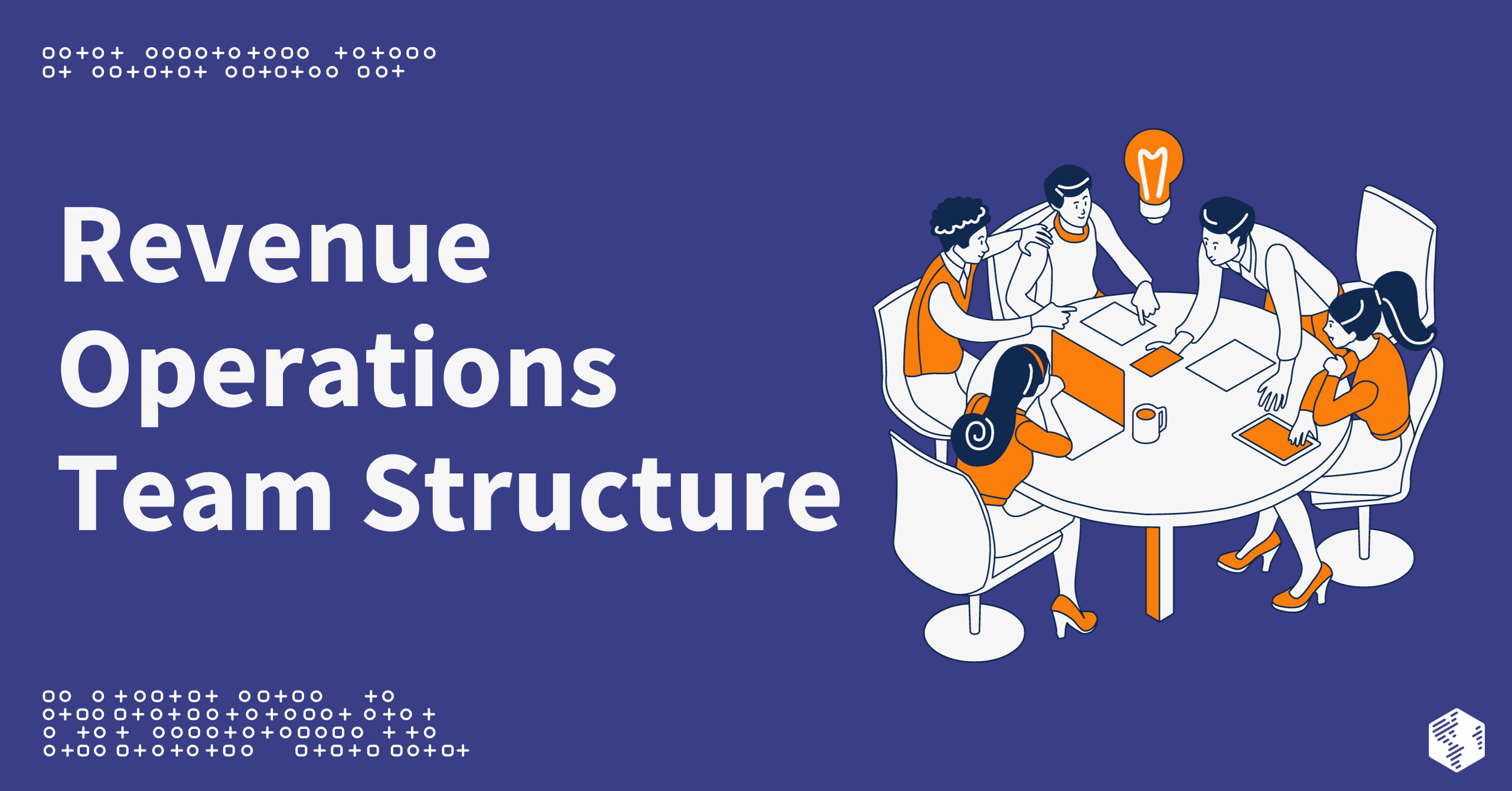Table Of Contents
Revenue operations (RevOps) can transform the growth potential of your business-to-business (B2B) and maximize long-term revenue. But when it comes to revenue operations, the devil is in the details: How you structure your RevOps team is the difference between failure and success.
But figuring out the best way to organize your RevOps function isn’t an easy task—especially if your business has a history of siloed departments.
Regardless, RevOps teams are a core part of today’s most successful businesses—and by 2025, Gartner predicts that 75% of the highest growth companies in the world will implement a revenue operations model.
It’s time for your B2B business to build a RevOps team.
The Role of a RevOps Team for B2B Companies
Revenue operations teams are responsible for maximizing revenue by identifying areas for improvement, streamlining operations, aligning customer-facing teams, integrating technology platforms, centralizing revenue data, and more.
A properly structured RevOps team is the backbone of a B2B organization, weaving together marketing, sales, and customer success departments; maintaining efficient use of resources; and optimizing revenue growth. With an efficient revenue operations department in place, your B2B company can work toward predictable, sustainable growth across all revenue streams.
The Key Components of a RevOps Team
RevOps requires collaboration from all revenue-generating business functions, specifically marketing, sales, and customer success. Since each of these teams plays an important part in driving revenue, the RevOps department’s responsibility is to align their strategies, processes, people, and platforms, ultimately optimizing revenue performance.
When these teams operate efficiently and collaboratively, it unlocks new growth potential for your business.
That’s why there are three key components that make up the RevOps department of a B2B company: Marketing operations (MarketingOps), sales operations (SalesOps), and customer success operations (CSOps).
Marketing Operations (MarketingOps)
The MarketingOps component of your RevOps team focuses on the growth and efficiency of your marketing department. MarketingOps helps your marketing initiatives run smoothly and ensures your B2B marketers have everything they need to succeed. RevOps collaborates with MarketingOps to align marketing strategies with organizational revenue goals.
Roles & Responsibilities
The roles and responsibilities of the MarketingOps team include the following:
- Lead lifecycle management
- Advertising and public relations
- Marketing metrics and analytics
- Customer data management
- Marketing automation
- Campaign analysis
Key Metrics
MarketingOps tracks several key metrics:
- Click-through rate (CTR)
- Customer acquisition cost (CAC)
- Conversion rate (CVR)
- Customer lifetime value (CLV)
- Bounce rate
- Marketing qualified lead (MQL) to sales qualified lead (SQL) conversion rate
- Marketing efficiency ratio (MER)
Tools & Technologies
MarketingOps manages many different technology platforms:
- Marketing automation tools
- Project management software
- Customer relationship management (CRM) platforms
- Conversational marketing tools
- Content management systems (CMS)
Sales Operations (SalesOps)
The SalesOps component of your RevOps team is responsible for improving the performance of your sales department and supporting their revenue-generation efforts. With the support of SalesOps, your sales representatives will have optimized processes, integrated tools, and up-to-date data at their fingertips—so they can focus on closing deals.
Roles & Responsibilities
SalesOps fulfills a variety of roles:
- New customer handoff
- Sales forecasting
- Sales pipeline management
- Sales productivity improvement
- Sales enablement
- Deal desk management
Key Metrics
Key SalesOps metrics include the following:
- Average sales cycle length
- CAC
- Forecast accuracy
- CLV
- Cost per lead
- MQL to SQL conversion rate
- Churn rate
Tools & Technologies
The SalesOps tech stack include several tools to help optimize sales processes and communication:
- CRM platform
- Sales enablement tools
- CMS
- Email automation software
- Contract lifecycle management platform
- Business intelligence software
Customer Success Operations (CSOps)
The CSOps function of your RevOps team is designed to improve communication, data analysis, and workflows with your customer success department. RevOps works with CSOps to create a unified customer journey and streamline your B2B organization’s customer relationship management strategy.
Roles & Responsibilities
CSOps is responsible for many roles, including the following:
- Customer data management
- CRM system monitoring
- Customer success platform integration
- Customer experience metrics and analysis
- Customer data collection
- Customer engagement initiatives
- New customer onboarding
Key Metrics
This function will measure several key customer success metrics:
- Customer satisfaction score (CSAT)
- Net promoter score (NPS)
- Churn rate
- CLV
- Customer retention cost (CRC)
- Customer effort score (CES)
Tools & Technologies
Many tools and technologies are used by CSOps:
- CRM platform
- Chat support tool
- Customer feedback software
- Customer health monitoring tools
- Knowledge base systems
How to Structure a Revenue Operations Team
Traditionally, B2B organizations treat operations like an afterthought. The result? Siloed teams that are difficult to consolidate and scale.
Structuring your RevOps department with collaboration and representation from all operations and customer-facing teams ensures it can effectively break down silos and align your organization under growth-focused revenue goals.
The specifics of your B2B company—size, industry, resources, current operations structure, etc.—will guide the formation of your RevOps team. While a smaller business may only require one or two individuals to manage revenue operations, larger companies might need to fill several operations-related roles. And businesses of any size can benefit from temporarily (or permanently) outsourcing RevOps to the experts.
No two RevOps departments look the same. The goal is to build a revenue operations team that supports your RevOps strategy and revenue goals.
RevOps Roles & Functions
While the MarketingOps, SalesOps, and CSOps teams fall under the RevOps umbrella, there are other revenue-related support roles that are also an essential part of a well-structured RevOps department:
- Team lead role: Every team needs a point person, which in the case of a RevOps team could be a manager, leader, or chief revenue officer (CRO)
- Project management function: Since RevOps success requires cross-departmental collaboration, your revenue operations team needs someone in charge of managing and prioritizing projects
- Analytics function: Revenue operations relies on data, so the analytics function is essential to making informed decisions
- Technology function: The platform pillar of RevOps is responsible for not only day-to-day software operations but also identifying, streamlining, customizing, and integrating your revenue operations tech stack
Each function may require a full team of experts or just one specialist to cover the position; alternatively, one employee may be responsible for multiple roles. The specifics depend on your B2B company’s unique situation.
Example RevOps Organizational Chart
How do these RevOps roles and functions intersect with MarketingOps, SalesOps, and CSOps?
We’ve designed an organizational chart for a hypothetical RevOps department to visualize how these teams function under the revenue operations umbrella.

Remember that there’s no one-size-fits-all RevOps model. The structure of your revenue operations team will depend on the size, needs, resources, and goals of your B2B organization. You may not need to create all of the positions listed in our example chart, and you may need to add additional roles to your team. Construct a B2B RevOps organizational hierarchy that reflects your revenue operations framework.
Need Help with Setting Up an Effective RevOps Team? Contact OneIMS
Establishing a RevOps team from scratch requires time, effort, and careful planning. But once your revenue operations team structure is in place, you will benefit from having your organization’s processes, platforms, and people aligned under the same revenue goals—leading to increased revenue and sustainable growth.
At OneIMS, our team of RevOps experts is ready to help your organization design and implement a revenue operations team that maximizes your growth potential and transforms your business into a revenue-generating machine. With a RevOps strategy in place, your company will optimize processes, streamline the customer journey, and function more efficiently.
We have a long history of working with companies in a variety of industries to develop innovative and data-driven marketing solutions, and we pride ourselves on producing measurable and sustainable results that lead to long-term growth.
But you don’t have to take our word for it. View testimonials from our clients and read our blog to get an idea of our training, experience, and track record of success.
Are you ready to achieve revenue growth? Schedule a consultation with us today to get started.






